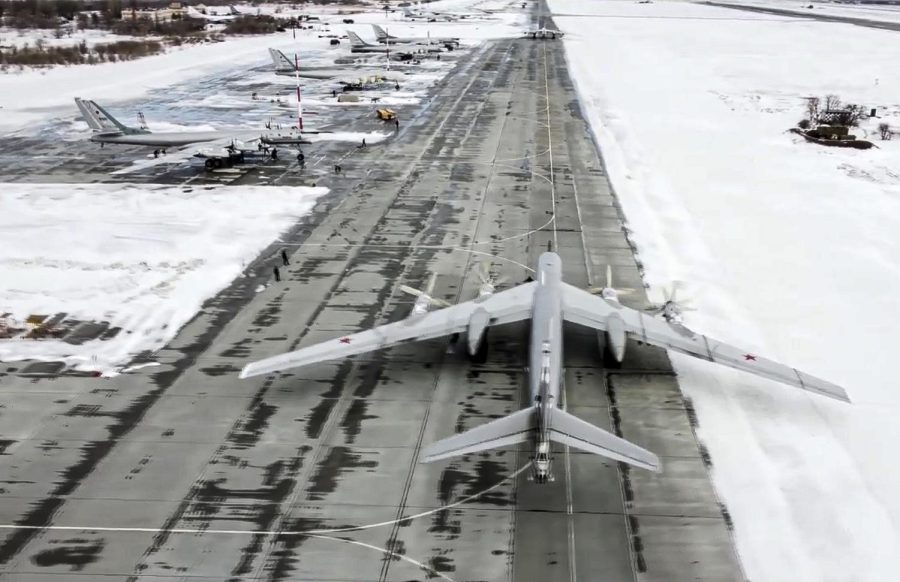Airfields 600 Kilometers Inside Russia Blown Up
January 5, 2023
Two Russian air bases deep within Russian territory were blown up on December 5th 2022. The Kremlin is claiming that this was the result of a fuel explosion. However, most of the outside world has come to the conclusion that this was the result of a drone strike by the Ukrainian army.
Russian media has stated that at 6:04 am, local time, there were large explosions at the Engles-2 airbase in the Saratov Oblast and the Dyagilevo air base in the Ryazan Oblast. Security camera footage from various houses and businesses verified this claim. The Kremlin claims that the blasts destroyed a pair of TU-95 bombers. These bombers are capable of launching the cruise missiles being used against the energy infrastructure of Ukraine. Alongside these planes, the Russians are claiming that three men were killed and that five were wounded.
Ukraine has not claimed responsibility for the strikes, but their air force has mocked the Russians for the incident and they would have significant motivation to do this. These strikes also happened only a day after Ukroboronprom, a conglomeration of Ukrainian arms manufacturers, announced that they had tested a drone with a 1000 kilometer range. While this claim could be an exaggerated one, it would explain how the strikes were achieved.
It has been theorized that the drone that conducted the strike was a modified version of the TU-141 drone. Originally meant to conduct reconnaissance missions, it could conceivably be modified to carry an explosive warhead. The Ukrainians, like all formerly Soviet states, would have a stockpile of this and other Soviet equipment. The drone also has a range of 1000 kilometers, which would be in line with the claims of Ukroboronprom. It is definitely worth mentioning that, with this range, the Ukrainians would be able to strike the Russian capital of Moscow.
Beyond the damage and potential for regular strikes on Russian territory, there is also the apparent failure of the Russian air defense systems. Given the military significance of these bases, any drones that could have been used in a strike should have been detected by radars and air defense networks. The governor of Kursk has claimed that they shot down two TU-141s, so attacks by them should have been prepared for. While this claim could have been a lie, the regions of Kursk and Belgorod have been subject to drone and missile strikes. This should have demonstrated to the Russians that they need to prepare for strikes on Russian territory.
There are two major possibilities to explain this. One is that Russian equipment is simply faulty and not up to the task of modern warfare. Given the repeated and extreme failures of Russian military equipment, this is a major possibility. The Russian military has experienced significant neglect and corruption, with one piece of footage displaying a Russian air defense system experiencing a malfunction and blowing itself up. With this and other incidents displaying Russian incompetence and lack of well maintained equipment, it is on the table that a missile developed in the late 1970s could get past Russian defenses.
It is also possible that the missile systems are needed for the frontlines too much. While the Russians were believed to have an effectively infinite supply of weapons from the Soviet era, reports have emerged that the Russians are buying munitions from North Korea, which would suggest that they are noticing shortages of supplies. There are also their stockpiles of smart munitions and weapons with modern electronics. The sanctions levied by the west have both damaged the Russian economy and prevented it from getting minerals critical for the manufacture of said electronics. This has effectively frozen the Russian chip industry and made them reliant on the industrial base of China.
Effectively, this means the Russians can make any more air defense systems and have to ration their existing stocks to wherever they are needed the most. Most of these systems have been sent to the frontline in Ukraine due to their heavy use of missile systems provided by NATO. With these new strikes within Russia itself, the Russians will either have to let the Ukrainians launch further strikes on the Russian homeland or will have to stretch their air defense network dangerously thin, leading to many more missiles slipping through. Either way, the Russian war effort is going to seriously and quickly deteriorate as this war drags on.




Anonymous • Jan 18, 2023 at 1:00 pm
I like how detailed the article is, it has lots of information!
Sophia Yee • Jan 17, 2023 at 11:40 am
I like the way that the information is said, and you can tell that you researched the topic thoroughly.
Brogk • Jan 17, 2023 at 11:36 am
very informative